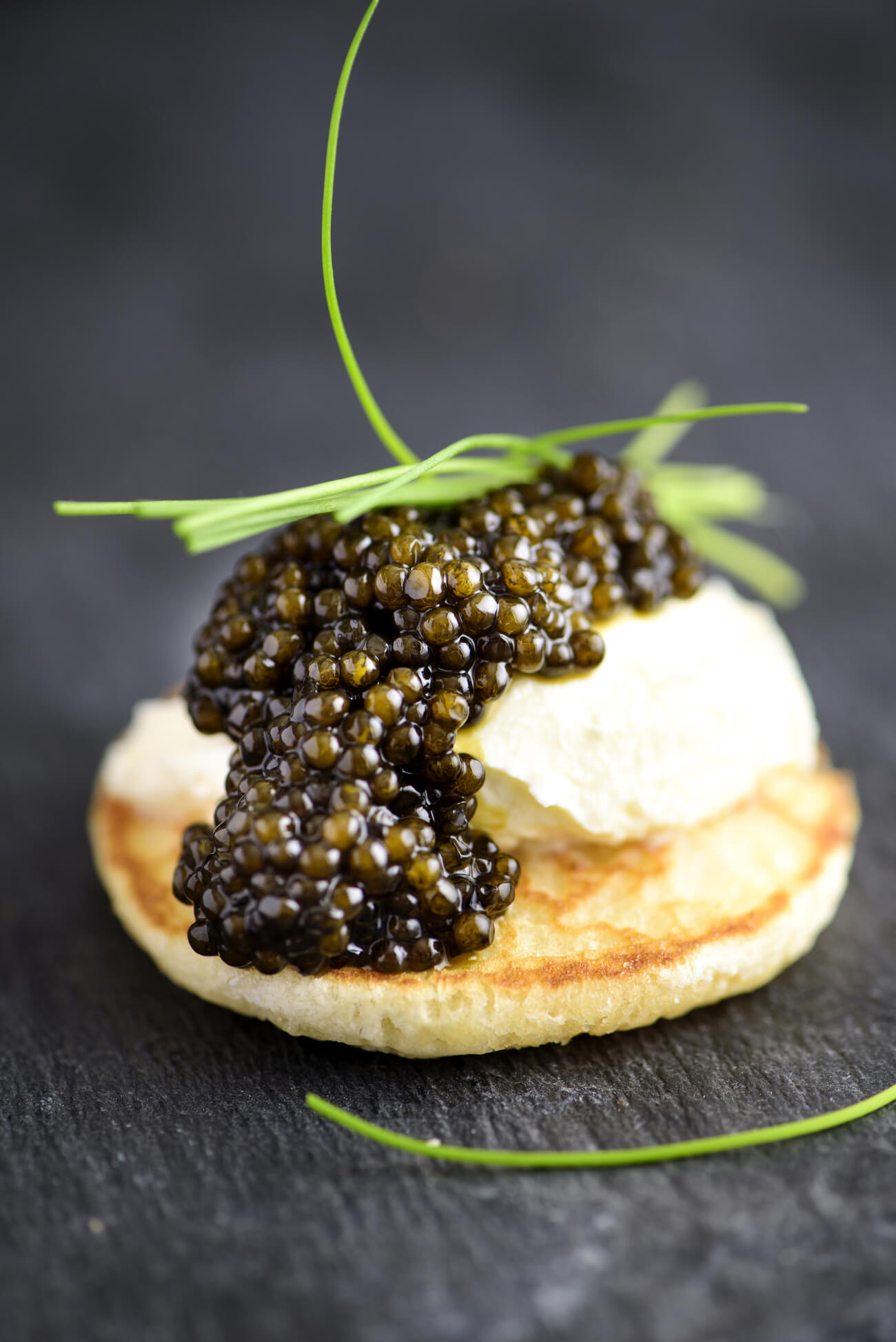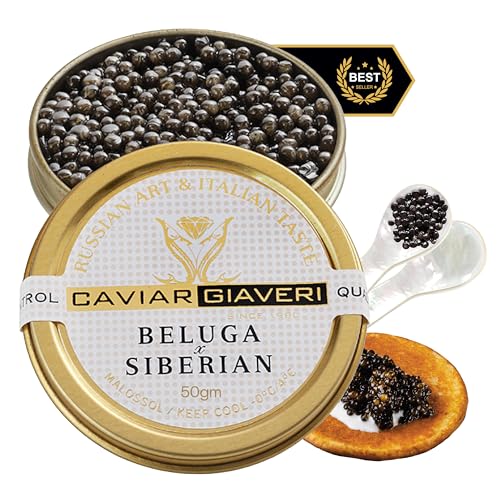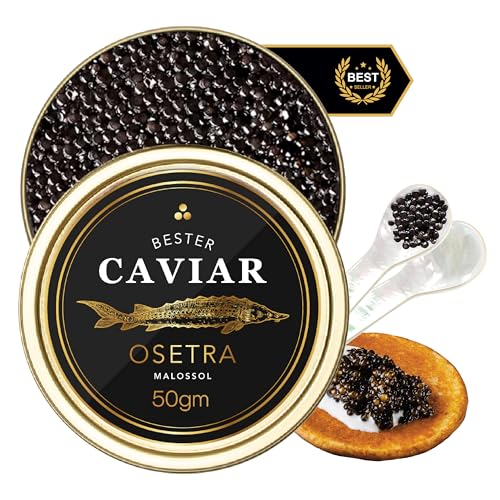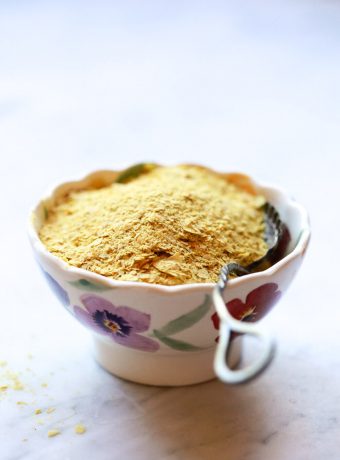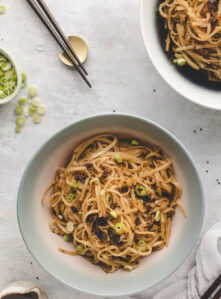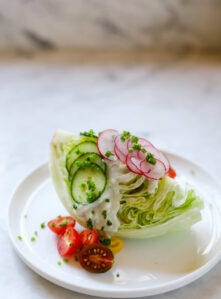Caviar: What is It and What Does it Taste Like?
Caviar makes elegant holiday hors d’oeuvres that you might encounter at parties. And you might be wondering, “What is caviar?” “What does caviar taste like?” “What’s the price?” and even “How do you eat caviar?” Just so you know, this post contains affiliate links, which means we make a small commission when you shop through them.
While at the grocery store recently, my daughter asked why all the tiny gold canisters were in a special refrigerated case. It got us to talking about what exactly caviar is, what it tastes like, why it’s expensive, and how to eat it. We also talked about the ethics and sustainability of this delicacy and if it’s really worth the price as one of the Most Expensive Foods.
If you have these same common questions, here are all the answers!
What is Caviar?
We all know that caviar is fish eggs, but who had the idea to begin eating it in the first place? And how exactly did it become a food associated with luxury?
It turns out that the story of caviar began in antiquity – specifically in Ancient Greece – and that it was a true delicacy even then! It was the reign of the Russian Czars that put caviar over the edge, however, after trading with the Greeks. They had designated their own “imperial caviar,” which elevated it to a gourmet offering, spawning a caviar culture that continues today.
In essence, the substance that we call caviar is the salt-cured roe (or unfertilized eggs) of the female sturgeon. It consists of small, usually black, unfertilized sturgeon roe that’s salted and packed into small tins. However, the color can vary from fish to fish (even of the same type). Sturgeon are migratory fish that can grow to weigh as much as 3,000 pounds!
You may have heard of different types of caviar, but that’s a case of semantics. Technically, only the eggs of the sturgeon are true caviar, according to the U.S. FDA. We sometimes call these eggs pearls or berries.
When we harvest the eggs from other fish, we simply call them roe. You may have tried salmon roe or masago at your favorite local sushi spot. Uni is also called roe, though it’s actually the reproductive organs of the sea urchin.
While sturgeon roe is the top of the line, different varieties offer different flavors, textures, and experiences.
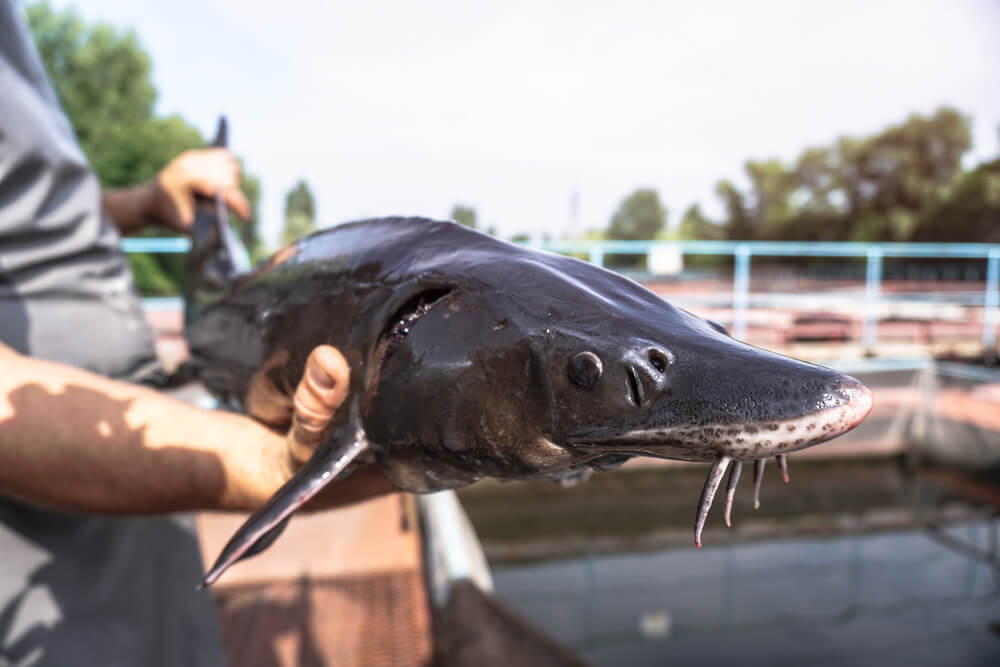
Farmed Sturgeon. Image: Shutterstock
Ethics and Sustainability
It’s important to consider how our food choices affect the environment and animals. If you’re vegan, caviar most certainly will go against your morals. It could be considered vegetarian if cruelty-free practices are used.
In the past, caviar harvesting meant the killing of sturgeon and removing them from the wild. Sadly, the overfishing of sturgeon led to the species becoming critically endangered.
Today, with fishing protections in place, much of the caviar is harvested more sustainably from farmed sturgeon.
Some farms strive for more ethical and sustainable caviar by allowing the fish to reach adulthood before killing them and using all of the meat in addition to the roe, while others use no-kill methods. The no-kill methods can vary from cesarian section operations to massaging the eggs out.
KC Caviar in the U.K. claims to produce cruelty-free caviar through a process in which the eggs are removed through natural spawning. California Caviar is another farm that claims to harvest caviar without harming fish.
Whether buying or eating caviar aligns with your morals is a personal decision, but it’s always best to be informed. For me, a few minutes of flavor is never worth causing suffering, and I’d probably go with an equally special ingredient like truffles. Oysters are another great seafood option that is very sustainable.
Vegan Caviar
If you follow a plant-based diet but want to try the caviar experience, there are vegan options.
Vegan caviar is made from black seaweed pearls and is available at Amazon or World Market. It’s much less expensive than the sturgeon variety, is cruelty-free, and can provide a similar experience.

Image: Bester Caviar via Amazon
Main Types of Caviar: Sevruga, Osetra, and Beluga
Several factors go into determining the price of caviar. One of those factors is the variety of sturgeon that the eggs come from. There are three main types, and each has different characteristics that make them distinct.
From there, the types of caviar receive a grade based on their quality. The largest and most uniform eggs are Grade 1 and will be the most costly. Less uniform eggs with a more delicate structure are Grade 2 and will cost somewhat less.
The three types of sturgeon that provide the majority of gourmet caviar are the beluga sturgeon, the osetra sturgeon, and the sevruga sturgeon.
Sevruga Caviar ($)
The most intense flavor comes from the surprisingly affordable sevruga caviar. You will recognize this variety by its small gray or black eggs. It has a buttery taste, with notes that suggest the salt and brine of the sea.
Sevruga caviar has a less fishy taste and is a great place for beginners to start.
Osetra Caviar ($$)
Osetra caviar might be the most popular caviar in the world. It is high-end but still falls on the affordable end of the spectrum. It varies in color but is usually a golden brown.
What does caviar taste like? The flavor of this variety varies, and I would describe it differently on different days. It has notes that are nutty, earthy, and even a little bit sweet!
Beluga Caviar ($$$)
It makes sense that one of the rarest caviars on earth would also be one of the most expensive! The beluga sturgeon population is small and shrinking, and this rare delicacy is going extinct along with it.
This caviar is as beautiful as it is delicious, ranging from deepest black to a unique deep green. The taste of caviar from the beluga sturgeon is most similar to the taste of hazelnuts. This is the type of caviar that I tried at that party long ago, known for the “Caspian pop!”
Why is Caviar so Expensive?
Bringing caviar to market is both time and labor-intensive. It takes from 7 to 10 years for sturgeon to begin producing eggs to harvest. Ultrasound is then used to determine egg production. If the eggs are ready, the fish is typically sedated and then the eggs are removed via c-section or other extraction methods.
Next, the delicate eggs are processed by rinsing to remove any broken eggs and other tissue. This is all done by hand and sometimes broken eggs are removed meticulously with tweezers. The harvested eggs are cleaned, salted, chilled, and aged for around three months.
The type of fish and quality also contribute to the vast price differences. The most expensive being Almas, a golden-colored variety from Iranian Beluga sturgeon that has sold for over $34,000 per 1 kg. You can currently get 4 oz. of Almas on Amazon for around $1,600.
Caviar prices have dropped in recent years thanks to sturgeon farming and the protection of the species, though it’s still a pricy delicacy.
What Does Caviar Taste Like?
Caviar taste can vary greatly depending on the type of caviar. However, in general, caviar is mildly salty and fishy, creamy, smooth, and even a little nutty.
Like good quality fish, caviar should taste fresh and not overly fishy, but more reminiscent of the flavor of the ocean. It also has an unexpected buttery, creamy taste.
The texture is just as important as flavor, however. It’s comprised of soft but not mushy, light, delicate, distinct beads that glide through the mouth and burst when bitten into.
Some people love the taste, while others strongly dislike it. It’s really a personal taste thing.
How to Eat Caviar
According to many caviar connoisseurs, the best way to enjoy caviar is to pick up a delicate little spoon and dig in, savoring every mouthful on its own! I recognize, though, that this might not be the best way to offer caviar to guests at a party or event!
Often, you want to provide some sort of base to serve as a vehicle for the caviar. Make sure that it’s something unsalted, as caviar is already salty on its own! It shouldn’t contribute too much flavor, as you want the caviar to be the star.
It’s common to see about a half teaspoon of caviar served on a toast point, blini, or simple cracker.
True caviar connoisseurs will tell you not to chew your caviar, but to savor the flavor by using your tongue to spread it around your mouth. Caviar is less of a food and more of an experience, and you’ll want to take the time to appreciate the many flavors of the ocean!
If you’re wondering how to store caviar when you’re serving it, you should set it on a bed of ice to keep it chilled. Afterward, it can keep for up to three days if sufficiently chilled. Ideally, you should eat it in one sitting.
Invite your guests to help themselves to a tiny amount using a non-metallic spoon. A dedicated caviar spoon is a beautiful, functional piece of art that won’t distort the flavor of the roe at all!
While caviar has traditionally been enjoyed as-is or very simply on canapes, it is being used more and more as a compliment to other dishes such as pasta or scrambled eggs. One restaurant in Paris is famous for its Baked Potato with Caviar.
Complimentary Ingredients
The two drinks you’re most likely to see served alongside caviar are vodka and Champagne. You might choose champagne if you’re looking to present a luxurious spread. You might prefer to entertain with vodka (perhaps a Vodka Martini) if you want to pair Russian with Russian and maintain a theme!
In truth, each of these drinks is a perfect accompaniment to rich and salty sturgeon roe! The bubbles and acidity of the Champagne will keep the sensory experience going with every sip. Likewise, the crisp flavor of high-end vodka will serve as a fine contrast to the briny bite of great caviar!
Caviar is an ingredient that is best kept simple. However, there are some ingredients that pair well.
- blini
- white toast points
- creme fraiche
- chives
- dill
- eggs
- French cuisine
- lemon
- lobster
- pasta
- raw onion
- shallots
- salt
- smoked salmon
- Russian cuisine
- potatoes
- vodka
- Champagne
- white chocolate
Health Benefits
It makes sense that caviar would be good for you. Even though it doesn’t look like your traditional seafood, it has many of the health benefits of a serving of fish! Some of the benefits of caviar might surprise you!
At the most basic level, caviar of all varieties contains a ton of vitamin B12 and important omega-3 fatty acids.
Caviar Safety During Pregnancy
Caviar malossol (salt-cured) is not pasteurized, and like other raw fish carries the risk of listeria. If you’re pregnant, please ask your doctor before indulging in fish roe.
What is Caviar + How to Eat it
Have you wondered, "what is caviar?" Here's what you need to know about what caviar tastes like and how to eat it! It's actually very simple!
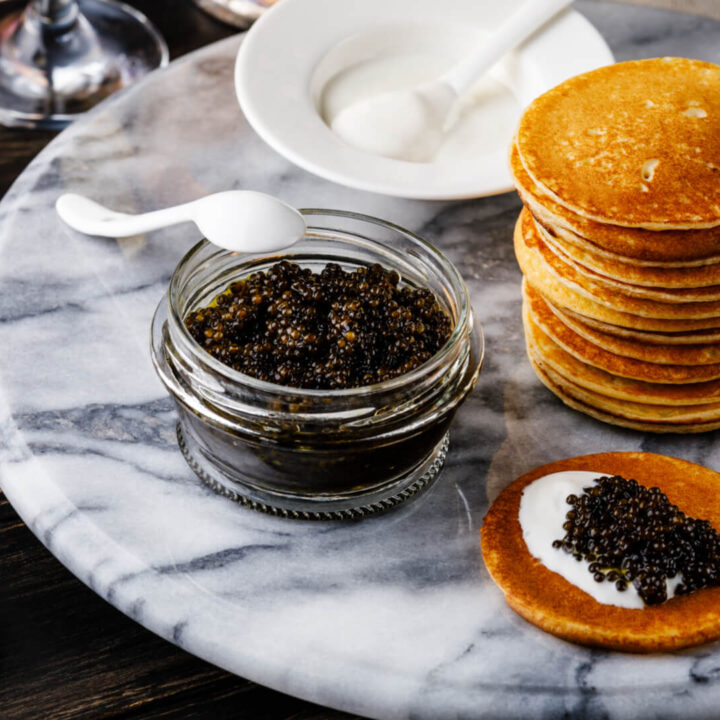
Ingredients
- 1 oz. caviar (vegan, Osetra, etc.)
- Crushed Ice
- 10 blinis or toast points
- creme fraiche
- 1 bunch fresh chives
Instructions
- Keep caviar refrigerated and unopened until you're ready to serve.
- When ready to serve, place the caviar canister on a bowl or dish of crushed ice to keep it cold.
- Use non-metallic small spoons to handle caviar. Metal oxidizes the eggs, which is why mother of pearl spoons are often used. Scoop caviar from top to bottom to avoid crushing the delicate eggs.
- Serve as-is, or on top of blinis, white toast, or cucumber slices topped with a dollop of creme fraiche and chives.
- Caviar connoisseurs generally recommend letting this ingredient be the star and keeping things simple, however others and many chefs add them to crepes, pasta, scrambled eggs, and more.
- Opened caviar can be kept in the refrigerator for about 3 days but is best eaten the day it is opened.
Notes
What is Caviar
The roe (unfertilized eggs) of sturgeon that has been salt-cured, aged for around 3 months, and packed into a small tin. It is a Russian delicacy often served on blinis or potatoes as elegant hors d’oeuvres. The three main types are: Sevruga, Osetra, and Beluga.
Taste
Caviar should taste like the ocean - just slightly salty and fishy.
Storing and Using
Never freeze or cook caviar. It must be served fresh and cold. You can add it to warm recipes such as pasta, potatoes, and scrambled eggs, but add it at the very end, as a garnish.
Recommended Products
As an Amazon Associate and member of other affiliate programs, I earn from qualifying purchases.
Nutrition Information:
Yield: 10 Serving Size: 1Amount Per Serving: Calories: 7Total Fat: 1gSaturated Fat: 0gTrans Fat: 0gUnsaturated Fat: 0gCholesterol: 17mgSodium: 43mgCarbohydrates: 0gFiber: 0gSugar: 0gProtein: 1g
Nutrition information is automatically calculated by Nutritionix. I am not a nutritionist and cannot guarantee accuracy. If your health depends on nutrition information, please calculate again with your favorite calculator.

